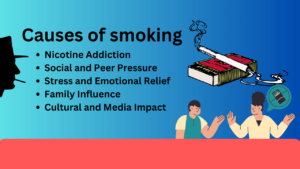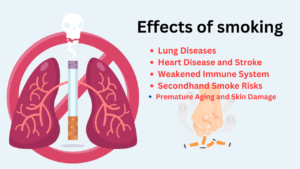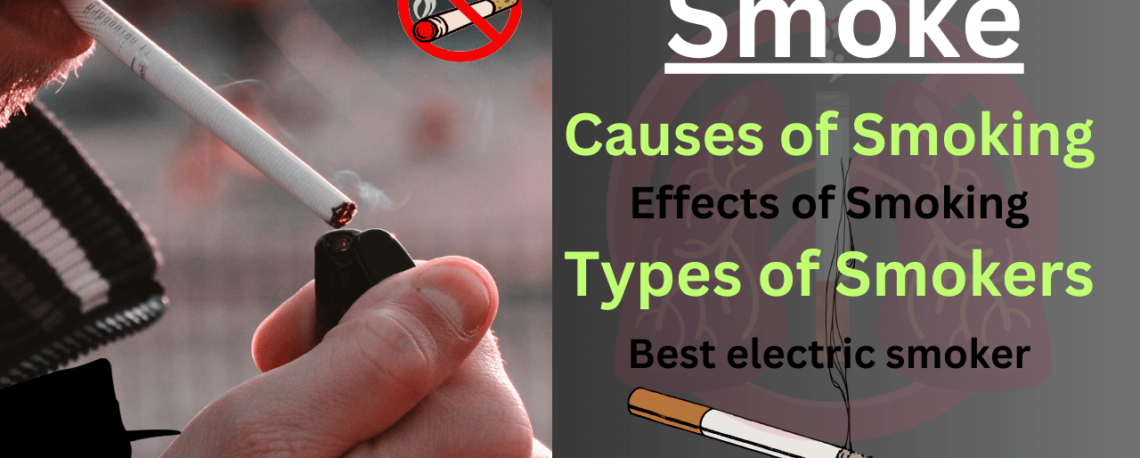Causes of Smoking: Smoking has been one of the most controversial public health concerns globally. Despite years of campaigns, regulations, and awareness, many people continue to smoke, exposing themselves and those around them to innumerable health risks. This article takes a closer look at the dangers of smoking, the societal impacts, and the various steps separate and governments are taking to combat the habit.
What Is Smoking
It is the process of inhaling the smoke of burning tobacco in cigarettes, cigars, or pipes. Tobacco contains nicotine, a highly addictive substance that triggers the release of chemicals in the brain, providing Provisional pleasure or relaxation. However, alongside nicotine, tobacco smoke contains more than 7,000 chemicals, many of which are toxic and harmful to human health.
causes of smoking

- Nicotine Addiction
Smoking leads to physical dependence due to nicotine, a highly addictive substance. It triggers the release of dopamine in the brain, making people crave more and forming a cycle of addiction. - Social and Peer Pressure
Peer influence, especially during adolescence, is a significant factor. Many people start smoking to fit in with friends or social groups where smoking is considered acceptable or cool. - Stress and Emotional Relief
Smoking is often used as a coping mechanism for stress, anxiety, or emotional problems. Smokers may turn to cigarettes for temporary relief from negative emotions, reinforcing the habit. - Family Influence
Growing up in a family where smoking is common increases the likelihood of starting. Children of smokers may perceive the habit as normal, making it easier for them to begin smoking. - Cultural and Media Impact
In some cultures and media portrayals, smoking is glamorized or integrated into daily rituals, making it seem more socially acceptable and attractive, particularly to younger individuals.
These factors collectively contribute to the initiation and continuation of smoking, making it a complex habit to break. (Causes of Smoking)
effects of smoking
- Lung Diseases
Smoking is the leading cause of lung cancer and chronic obstructive pulmonary disease (COPD), which includes emphysema and chronic bronchitis. It severely damages lung tissues over time. - Heart Disease and Stroke
Smoking increases the risk of heart attacks and strokes by damaging blood vessels, leading to plaque buildup, high blood pressure, and reduced blood flow. - Weakened Immune System
Smokers are more susceptible to infections and diseases due to a compromised immune system, making it harder for the body to fight illnesses. - Secondhand Smoke Risks
Non-smokers exposed to secondhand smoke face health risks, including lung cancer, heart disease, and respiratory infections, especially in children. - Premature Aging and Skin Damage
Smoking accelerates skin aging, leading to wrinkles and dullness. It reduces blood flow, depletes oxygen and nutrients in the skin, and negatively impacts appearance.

cigarette smoker
Definition
A cigarette smoker is an individual who regularly smokes cigarettes, inhaling the smoke produced by burning tobacco. This habit can lead to various physical and psychological dependencies.
Key Characteristics
- Health Risks
- Chronic Diseases: Cigarette smokers are at a high risk for chronic illnesses, including lung cancer, heart disease, stroke, and respiratory diseases such as chronic obstructive pulmonary disease (COPD).
- Shortened Lifespan: Smokers tend to have a reduced life expectancy due to smoking-related diseases and conditions.
- Addiction
- Nicotine Dependence: Most cigarette smokers develop a dependence on nicotine, the addictive substance in tobacco. This dependence can make quitting difficult and often leads to withdrawal symptoms when trying to reduce or stop smoking.
- Behavioral Aspects
- Smoking Triggers: Many smokers associate smoking with specific activities or routines, such as having coffee, socializing, or taking breaks at work, which can reinforce the habit.
- Coping Mechanism: Some individuals use smoking as a way to manage stress, anxiety, or emotional challenges, viewing it as a means of relaxation.
- Social and Cultural Factors
- Peer Influence: Social circles can significantly influence smoking behavior. Many smokers start during adolescence due to peer pressure or the desire to fit in.
- Cultural Acceptance: In some cultures, smoking may be more socially acceptable, which can perpetuate the habit among individuals within those communities.
- Cessation Efforts
- Support Systems: Many resources exist to assist smokers in quitting, including counseling, support groups, and medications.
- Public Health Initiatives: Anti-smoking campaigns and regulations aim to reduce smoking rates and educate the public about the dangers of smoking.
what is tobacco
Definition
Tobacco is a plant belonging to the genus Nicotiana, primarily grown for its leaves, which are processed and used in various products, most notably cigarettes, cigars, and chewing tobacco. The most commonly cultivated species is Nicotiana tabacum.
Key Characteristics
- Chemical Composition
Tobacco leaves contain over 7,000 chemicals, including nicotine, tar, carbon monoxide, and various carcinogens. Nicotine is the primary psychoactive ingredient, leading to addiction. - Forms of Tobacco Products
- Cigarettes: Rolled tobacco in paper, designed for smoking.
- Cigars: Rolled tobacco leaves, typically larger than cigarettes and with a different smoking experience.
- Pipe Tobacco: Tobacco specially prepared for use in pipes.
- Chewing Tobacco: Smokeless tobacco chewed or placed between the gum and cheek.
- Snuff: Finely ground tobacco that can be inhaled or placed in the mouth.
- Health Risks
Tobacco use is linked to numerous health issues, including:- Cancer: Major cause of various cancers, including lung, throat, mouth, and bladder.
- Cardiovascular Disease: Increases the risk of heart attacks, strokes, and other heart-related conditions.
- Respiratory Issues: Contributes to chronic obstructive pulmonary disease (COPD) and other respiratory illnesses.
- Economic Impact
The tobacco industry is a significant economic force, providing jobs and revenue. However, the healthcare costs associated with tobacco-related illnesses create a substantial financial burden on public health systems. - Regulation and Public Health Initiatives
Many countries have implemented strict regulations on tobacco sales, advertising, and public smoking. Public health campaigns aim to reduce tobacco use and educate people about its health risks.
scientific name of tobacco
types of smokers/types of smoke
- Casual Smokers
- Description: Individuals who smoke occasionally, often in social situations or during specific events (e.g., parties, gatherings).
- Characteristics: They may not smoke daily and often view it as a recreational activity rather than a habit.
- Regular Smokers
- Description: Individuals who smoke daily, typically consume a consistent number of cigarettes.
- Characteristics: They have developed a routine around smoking, often relying on it for stress relief or social interaction.
- Heavy Smokers
- Description: Smokers who consume a large number of cigarettes daily (often defined as more than 20 cigarettes).
- Characteristics: They are at a higher risk for health complications due to their intense exposure to nicotine and other harmful substances.
- Chain Smokers
- Description: Individuals who light a new cigarette immediately after finishing the previous one, often smoke continuously throughout the day.
- Characteristics: This behavior reflects a strong nicotine dependence, making it challenging for them to go without smoking for extended periods.
- Social Smokers
- Description: Smokers primarily smoke in social settings, such as when with friends or at parties, rather than as a regular part of their daily routine.
- Characteristics: They may not consider themselves regular smokers and often try to limit their intake to social situations.
- Quitters
- Description: Individuals who have recently quit smoking or are in the process of quitting.
- Characteristics: They may still experience cravings and are often motivated to avoid triggers that could lead to relapse.
electric smoker
Here’s a simple three-step process for using an electric smoker:
- Preparation:
- Choose your meat or vegetables and season them as desired. If you’re using wood chips, soak them in water for about 30 minutes before adding them to the smoker to enhance the smoke flavor.
- Set Up the Smoker:
- Fill the wood chip tray and plug in the smoker. Preheat it to your desired smoking temperature (usually between 225°F to 250°F). Once preheated, place your food on the racks.
- Smoking Process:
- Close the smoker door and let the food smoke for the recommended time. Check periodically to ensure the temperature remains consistent. Once done, remove the food and let it rest for a few minutes before serving.
Enjoy your smoked dishes! Let me know if you need more details on any step. (Causes of Smoking)
best electric smoker for beginners
If you’re new to smoking, an electric smoker is a great choice due to its ease of use and consistent results. Here are some of the best electric smokers for beginners:
- Masterbuilt MB20070210 Electric Digital Smoker
- Features: Digital control panel, four smoking racks, and a built-in meat thermometer.
- Pros: User-friendly design, good temperature control, and spacious cooking area.
- Cons: Requires electricity, which may limit portability.
- Cuisinart COS-330 Electric Smoker
- Features: 30-inch size, three removable shelves, and a water tray for added moisture.
- Pros: Affordable, compact design, and simple assembly.
- Cons: Limited smoking capacity for larger gatherings.
- Smoke Hollow 26142E Electric Smoker
- Features: 26-inch size, double-door design, and adjustable air dampers.
- Pros: Good build quality, affordable, and easy to use for beginners.
- Cons: Some users report uneven heating.
- Bradley BTDS108P Digital Smoker
- Features: Digital control for temperature and time, with a built-in smoke generator.
- Pros: Automated smoking process, excellent flavor, and versatility.
- Cons: Higher price point compared to basic models.
- Pit Boss 77251 2.5 Series Electric Smoker
- Features: 2.5 cubic feet of cooking space, adjustable temperature control, and a porcelain-coated water pan.
- Pros: Great for beginners with an easy-to-read control panel and good heat retention.
- Cons: Some users find it a bit bulky.
Tips for Choosing an Electric Smoker
- Size: Consider how much cooking space you’ll need based on your typical cooking volume.
- Temperature Control: Look for models with precise temperature settings for better smoking results.
- Ease of Use: Choose a straightforward model, especially if you’re a beginner.
- Reviews: Check customer reviews for insights on reliability and performance.
smoking kills
Here’s a step-by-step breakdown of the concept “Smoking Kills,” focusing on the health risks associated with smoking tobacco:
1: Understanding the Risks
- Health Conditions: Smoking is linked to numerous serious health issues, including lung cancer, heart disease, stroke, and chronic obstructive pulmonary disease (COPD).
- Statistics: Highlight statistics showing the prevalence of smoking-related diseases. For instance, smoking accounts for approximately 80% of lung cancer cases.
2: Impact on the Body
- Respiratory System: Explain how smoking damages lung tissues, reduces lung function, and increases the risk of infections.
- Cardiovascular System: Discuss how smoking contributes to the buildup of plaque in arteries, leading to heart disease and stroke.
- Immune System: Describe how smoking weakens the immune system, making it harder for the body to fight infections.
3: Secondhand Smoke
- Definition: Define secondhand smoke as the smoke exhaled by smokers or that comes from burning tobacco products.
- Health Risks: Outline the dangers of secondhand smoke exposure for non-smokers, including respiratory problems and increased risk of cancer.
- Vulnerable Populations: Highlight groups particularly at risk, such as children, pregnant women, and individuals with pre-existing health conditions.
4: Addiction and Withdrawal
- Nicotine Addiction: Explain how nicotine creates dependence, making quitting difficult for many smokers.
- Withdrawal Symptoms: Discuss common withdrawal symptoms (e.g., irritability, cravings, anxiety) that can occur when attempting to quit smoking.
5: Quitting Smoking
- Benefits of Quitting: Emphasize the immediate and long-term health benefits of quitting smoking, including reduced disease risks and improved overall health.
- Resources for Support: Provide information on resources, such as quitlines, support groups, and nicotine replacement therapies, to help individuals quit smoking.
More Read: (Causes of Smoking)
Diabetes symptoms and its cure
Benefits of chirata in Bengali
Conclusion
Smoking remains a global health threat, responsible for millions of deaths each year. However, the tide is slowly turning with increasing awareness, better resources for quitting, and stronger regulations. Quitting smoking is challenging but achievable with the right support and tools. For those who smoke, it’s never too late to quit and start living a healthier life, free from the harmful effects of tobacco. (Causes of Smoking)
Thanks for being with us
